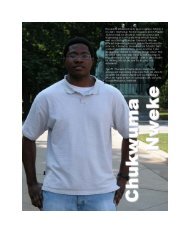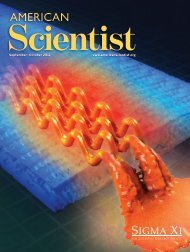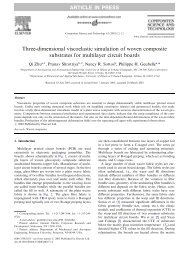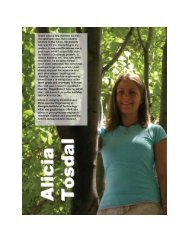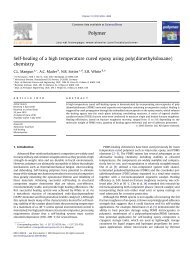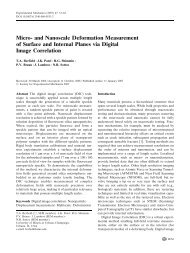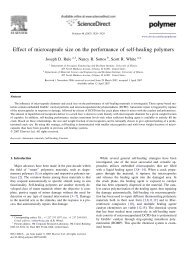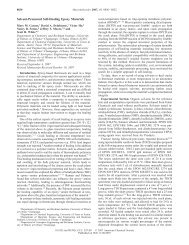Bioinspired Materials for Self-Cleaning and Self-Healing - Sottos ...
Bioinspired Materials for Self-Cleaning and Self-Healing - Sottos ...
Bioinspired Materials for Self-Cleaning and Self-Healing - Sottos ...
- No tags were found...
You also want an ePaper? Increase the reach of your titles
YUMPU automatically turns print PDFs into web optimized ePapers that Google loves.
<strong>Bioinspired</strong> <strong>Materials</strong> <strong>for</strong> <strong>Self</strong>-<strong>Cleaning</strong> <strong>and</strong> <strong>Self</strong>-<strong>Healing</strong><strong>and</strong> represents the first step in the developmentof materials systems with greatlyextended lifetimes.In biological systems, chemical signalsreleased at the site of fracture initiate asystemic response that transports repairagents to the site of injury <strong>and</strong> pro -motes healing (Figure 2a). The biologicalprocesses that control tissue responseto injury <strong>and</strong> repair are extraordinarilycomplex, involving inflammation, woundclosure, <strong>and</strong> matrix remodeling. 49 Coagulation<strong>and</strong> inflammation begin immediatelywhen tissue is wounded. After about24 hours, cell proliferation <strong>and</strong> matrixdeposition begin to close the wound.During the final stage of healing (whichcan take several days), the extracellularmatrix is synthesized <strong>and</strong> remodeled asthe tissue regains strength <strong>and</strong> function.Ideally, synthetic reproduction of the healingprocess in a material requires an initialrapid response to mitigate further damage,efficient transport of reactive materialsto the damage site, <strong>and</strong> structuralregeneration to recover full per<strong>for</strong>mance.Although no materials system yetaccomplishes this complete set of autonomichealing processes, crack healinghas been explored in a wide spectrum ofmaterials. 50 The efficiency of crack healing<strong>for</strong> structural materials is defined as theability to recover the mechanical integrityof the virgin (undamaged) material,including such properties as fracturetoughness (K IC ), fracture energy (G c ), elasticstiffness (E), <strong>and</strong> strength (σ ult ). Forsome materials systems, healing isachieved autonomically (independently<strong>and</strong> automatically) without any externalintervention, whereas others require additionalenergy (such as heat) to heal.In polymers <strong>and</strong> polymer composites,two distinct approaches <strong>for</strong> self-healinghave emerged. In the first, the crackmendingprocess is initiated by an externalthermal-, photo-, mechanical- or chemicalinducedstimulus. Successful crack healinghas been achieved through both moleculardiffusion <strong>and</strong> thermally reversible solidstatereactions. In the second approach,damage in the <strong>for</strong>m of a crack triggers therelease of healing agents stored in thematerial, as also occurs <strong>for</strong> fracture eventsin biological systems (Figure 2b). Bothcompartmentalized <strong>and</strong> continuous deliverystrategies have been demonstrated.Site-specific crack healing is achievedautonomically in this approach, withoutany external intervention.Thermally Induced Crack MendingCrack healing has been achieved in arange of polymer systems through the useof heat <strong>and</strong> pressure to promote diffusionabepidermiscrackgranulationtissuefibrin clotof polymer chains <strong>and</strong>/or chemicalchanges (Figure 3). In many cross-linkedpolymers, healing occurs through chaininterdiffusion if there is physical contactbetween the crack planes <strong>and</strong> sufficientviscoelastic de<strong>for</strong>mation <strong>and</strong> wetting. 51,52An increase of the temperature above theglass transition, T g , <strong>and</strong> application ofpressure significantly enhance the mendingprocess. 51 The manual addition of solventalso promotes polymer healing byeffectively lowering T g . 53 For certainionomers, self-healing is triggered by thermalenergy transferred to the polymerduring a projectile puncture event. 54Thermally induced reversible polymerizations,in which the material contains areversible or dynamic covalent bond, havealso been exploited <strong>for</strong> crack healing.Chen <strong>and</strong> co-workers used a retroDiels–Alder strategy to prepare thermallyrepairable cross-linked polymers (Figure3). 55,56 With the application of heatbloodvesselsdermis1 2 3Figure 2. (a) Schematic of an intermediate stage of biological wound healing in skin.Tissue damage triggers bleeding, which is followed by the <strong>for</strong>mation of a fibrin clot.Fibroblast cells migrate to the wound site enabling the creation of granulation tissue tofill the wound. 49 (b) Demonstration of bioinspired damage-triggered release of amicroencapsulated healing agent in a polymer specimen: ➀ schematic ofcompartmentalized healing agent stored in a matrix; ➁ release of dyed healing agent intothe crack plane, which leads to a synthetic clotting (polymerization) process to bond thecrack faces; <strong>and</strong> ➂ one-half of the fracture surface revealing ruptured capsules.(120–150°C) <strong>and</strong> modest pressure, thesepolymers demonstrate high crack-healingefficiencies based on recovery of fracturetoughness. 55–57 More recently, a thermoreversible,self-healing rubber based onhydrogen bonding has been reported. 58Details on the underlying chemistry ofthese <strong>and</strong> several new polymer systemsare described in the article by Williamset al. in this issue.Trigger <strong>and</strong> Release <strong>for</strong> Autonomic<strong>Healing</strong>Polymers that self-heal with no externalintervention rely on the quiescent, stablestorage of liquid healing agents <strong>and</strong> anactivator or catalyst within the material.The healing components must remainactive <strong>and</strong> separated until damage occurs,without significantly impacting the inherentproperties of the material. Effectivestorage <strong>and</strong> release has been achievedwith healing-agent-filled microcapsulesMRS BULLETIN • VOLUME 33 • AUGUST 2008 • www.mrs.org/bulletin 735





